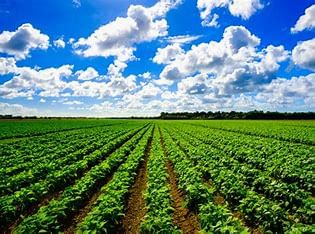NCERT Summary: Agriculture | Geography for UPSC CSE PDF Download
| Table of contents |

|
| Introduction |

|
| Agriculture |

|
| Farm System |

|
| Types of Farming |

|
| Major Crops |

|
| Jute and Coffee |

|
| Agricultural Development |

|
Introduction
- Primary Activities refer to the extraction and production of natural resources, including agriculture, fishing, and gathering.
- Secondary Activities involve the processing of these resources, such as manufacturing steel, baking bread, and weaving cloth.
- Tertiary Activities encompass services that provide support, including transport, trade, banking, insurance, and advertising.
Agriculture
- Agriculture is a fundamental aspect of primary activities, involving the cultivation of a variety of products such as crops, fruits, vegetables, flowers, and the rearing of livestock.
- In developing countries, over two-thirds of the population is engaged in agricultural activities, highlighting its crucial role in these economies.
- Successful agricultural practices rely on factors like soil quality and climate. Arable land, which is the specific area designated for growing crops, is essential for effective agriculture.

Farm System
- Key inputs in agriculture include seeds, fertilisers, machinery, and labour.
- Operations such as ploughing, sowing, irrigation, weeding, and harvesting are essential.
- The outputs from the system comprise crops, wool, dairy, and poultry products.
Types of Farming
Farming can be broadly classified into two types based on geographical conditions, demand for produce, labour, and technology levels:
- Subsistence Farming. This type is practised to meet the needs of the farmer's family directly.
- Commercial Farming. This is conducted primarily for sale in the market but may also include some personal consumption.
Types of Subsistence Farming
- Intensive Subsistence Farming. Farmers work on small plots using basic tools and rely heavily on labour. This is common in regions with many sunny days and fertile soil, allowing multiple crops to be grown each year. Main crops include rice, wheat, maize, pulses, and oilseeds. This farming is primarily found in densely populated areas of monsoon regions in South, Southeast, and East Asia.
- Primitive Subsistence Farming. This includes shifting cultivation and nomadic herding.
- Shifting Cultivation. Practised in heavily forested regions like the Amazon basin, tropical Africa, parts of Southeast Asia, and Northeast India. The method involves clearing land by burning trees and mixing the ashes with soil for cultivation, moving to new plots when soil fertility declines. This is also known as 'slash and burn' agriculture.
- Nomadic Herding. Common in semi-arid and arid regions such as the Sahara, Central Asia, Rajasthan, and Jammu and Kashmir. Herders move with their animals in search of fodder and water along specific routes. Common animals include sheep, camels, yaks, and goats, which provide products like milk, meat, wool, and hides.

- Commercial Farming. In this type, both crops and animals are raised for sale in the market. It involves large-scale cultivation and significant capital investment. Mechanisation is crucial in commercial farming operations.
Types of Commercial Farming
- Commercial Grain Farming. Focuses on growing crops for commercial purposes, like wheat and maize. Commonly found in the temperate grasslands of North America, Europe, and Asia. Due to severe winters, only one crop can be grown each season.
- Mixed Farming. Combines crop cultivation with livestock rearing. Practised in regions like Europe, eastern USA, Argentina, etc.
- Plantation Agriculture. Involves growing a single crop like tea, coffee, or sugarcane. This type requires substantial labour and capital investment. Common in tropical regions and often involves processing the produce.

Major Crops
Rice
- Rice is a staple food in tropical and sub-tropical regions.
- It thrives in conditions of high temperature, humidity, and adequate rainfall.
- Rice prefers alluvial clayey soil, which has good water retention properties.
- The top producers of rice include China, India, Japan, Sri Lanka, and Egypt.
Wheat
- Wheat grows best in regions with moderate temperatures.
- It requires adequate rainfall during its growing period.
- Bright sunshine is crucial during the harvest period.
- Wheat thrives in well-drained loamy soil.
- Major wheat-producing countries include the USA, Canada, Argentina, Russia, Ukraine, Australia, and India, where it is primarily grown in winter.
Millets
- Millets, also known as coarse grains, are grown in less fertile and sandy soils.
- These hardy crops require low rainfall and can tolerate moderate to high temperatures.
- In India, common varieties include Jowar, Bajra, and Ragi.
- Other countries such as Nigeria, China, and Niger also cultivate millets.
Maize
- Maize (corn) grows well in areas with moderate temperatures and adequate rainfall.
- It requires ample sunlight and well-drained, fertile soils for optimal growth.
- Key producers of maize include North America, Brazil, China, Russia, Canada, India, and Mexico.
Cotton
- Cotton requires high temperatures and low to moderate rainfall.
- It needs at least 210 frost-free days and plenty of sunshine to grow.
- Cotton thrives in black soils and alluvial soils.
- Major cotton producers include China, the USA, India, Pakistan, Brazil, and Egypt, as cotton is vital for the textile industry.
Jute
- Jute is another significant crop that grows well under specific conditions.
- It typically requires a warm climate and ample moisture.
- Countries like India and Bangladesh are leading producers of jute.

Jute and Coffee
Jute is often called the 'Golden Fibre' because of its value. This plant thrives in specific conditions:
- It requires very high temperatures to grow.
- Heavy rainfall is essential for its cultivation.
- A humid climate is also necessary for jute to flourish.
Jute is primarily grown in the eastern part of India and the Ganges delta. India and Bangladesh are the leading producers of jute worldwide.
Coffee plants prefer:
- Warm and wet climates, which provide the right conditions for growth.
- Well-drained loamy soil, particularly on hill slopes, which helps prevent waterlogging and provides essential nutrients.
Major coffee-producing countries include Brazil, Colombia, and India. In India, coffee is commonly found in subtropical areas, especially thriving at elevations above 1000 meters, where the climate is cooler and more suitable for coffee cultivation.
Agricultural Development
Agricultural development refers to efforts aimed at boosting farm production to satisfy the increasing needs of the population.
Approaches to Agricultural Development
- Expanding cultivated land, diversifying crops, enhancing irrigation, and utilizing fertilizers along with high-yield seed varieties.
- Goal: The primary goal of agricultural development is to strengthen food security for the population.
Characteristics of a Small-Scale Farm in India
- Use of High-Yielding Varieties (HYVs): Farmers adopt HYVs developed by research institutions to increase crop productivity.
- Seeking Advice: Farmers consult peers, family, or government sources for guidance on farming practices.
- Land Preparation: Tractors or bullock carts are used for preparing land for cultivation.
- Irrigation: Tube wells are employed for irrigation to ensure adequate water supply.
- Livestock: Keeping livestock provides additional income and supports farm activities.
- Family Involvement: All family members participate in farming activities, contributing to labour and management.
- Financial Support: Farmers rely on bank loans to purchase seeds and equipment necessary for farming.
- Storage Issues: Lack of proper storage facilities forces farmers to sell produce prematurely.
- Government Support: Initiatives like the Pradhan Mantri Kisan Samman Nidhi aim to improve agricultural infrastructure and support farmers.
- Sustainable Practices: Farmers increasingly adopt sustainable agricultural practices to ensure long-term viability and environmental health.
|
175 videos|619 docs|192 tests
|















